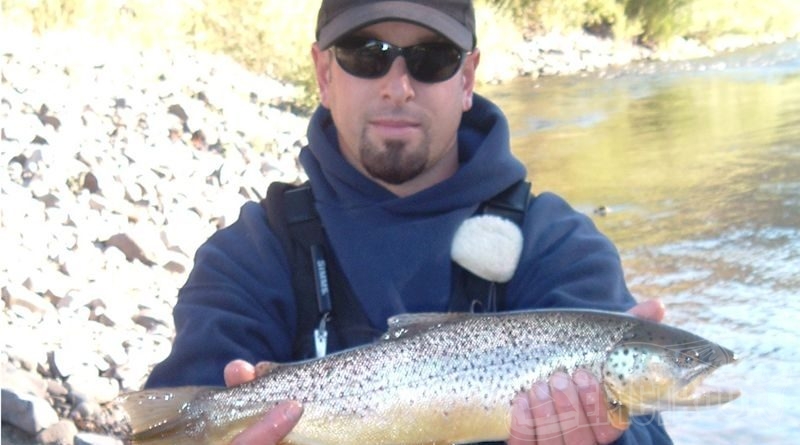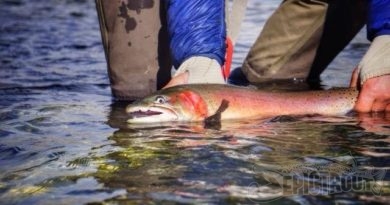Baitfishing With A Fly
The following is a classic article Mark Wiza wrote for a west coast fishing publication over a decade ago. Some things never get old though, and Mark’s tips and humor are just as relevant today. It’s time to bring this great read back for a new generation of anglers here at Epic Trout!
-Brad Stout,
Baitfishing with a fly
By Mark Wiza
I don’t fly fish because it’s sporting, although with a rod like a willow branch, four pound test tippet, and a hook smaller than my pinkie-nail, it sure as hell is.
I don’t fly fish because it’s fashionable, which is evident at any popular California wild-trout stream, where anglers with more money than sense fill every spot in the parking areas with monstrous contrivances known as “luxury sport utility vehicles”, then parade up and down the banks in the latest finery from Orvis and L.L. Bean.
I use flies because they are the best way to catch fish in my local rivers.
“They’re hitting on dries!” is not surprisingly the high point of most conversations at the fly shop I frequent, since the opportunity to beguile and hook fish with surface imitations is widely considered the pinnacle of fly angling experience. Of course, dry fly fishing has a long and distinguished history, in which elitism and snobbery play an important role. If you shun and drive away a subsurface fly angler, you won’t have to explain why he outfishes you. Still, even us baitcasting bumpkins who prefer dragging rubber worms on lake bottoms also occasionally enjoy the shock and excitement of having a bass explode on a topwater lure- we’re just not stupid enough to keep beating the surface to a froth when better prospects are to be found in the depths.
Speaking of shock and excitement, you should have seen the faces of the hotshot young guides when I first started going to the shop and replying “So what?” to all the dry commentary. They’d recoil in horror at my tales of catching big fish in the Carson and Walker with deeply sunk egg-patterns, the fish violently slamming my flies beneath others delicately sipping naturals from a surface hatch of mayflies or caddis. One guy even told me that I wasn’t actually fly fishing, but rather bait fishing with a fly.
Hey, that has a nice ring to it. I think I’ll call this series of articles Bait Fishing With a Fly, or maybe Trailer Trash Trout -the opposite of well-heeled, upper crusted, limp wristed fly fishing- the lowest, crudest, most despicable perversion of the sport. Over the next few weeks you’ll learn the secrets of the following blasphemies:
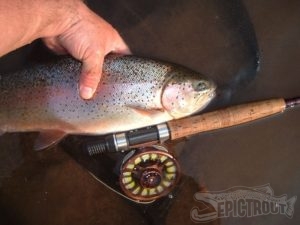
Strike Indicators: Yes, big red bobbers have left the bluegill pond and gone upscale! Forget tedious false casting and applications of greasy floatant to keep your fly riding high in the surface film. We’re talking Styrofoam! No more eyestrain from trying to follow the drift of a tiny, feathered speck or watching for a twitch in hair-thin, transparent tippet material. Just follow the bouncing ball.
Attractor Nymphs: Why match a boring old hatch and compete with countless natural flies when you can fish something completely ridiculous! Think of your fly as a young starlet and the trout as hungry Hollywood casting directors. Do you want to blend in or stand out?
Those Funny Rubber Pants: Learn to walk to the middle of the river, to the very top of your chest waders, and to bring a duffel bag with towels and extra clothes.
Getting the Lead Out: There are three important depths to fish for best success with this method: bottom, bottom and bottom. Learn how splitshot and weighted flies can keep you consistently tapping the rocks, and how to be the hot rod on the water by chucking this hardware while avoiding any mention of the movie A River runs Through It.
Multiple Fly Rigs: Can’t decide which of two or even three favorite flies to use first? Why choose? Fish them all.
Fishing Blind: I’m not talking about drinking corn liquor from a Mason jar then grabbing the fly rod, but I once woke up in bed with a terrible hangover and an eight pound squawfish. In a decent sized stream, using a nymph and strike indicator, you usually don’t need to be able to spot feeding trout, only the likely holding areas.
Lest you lawn-chair anglers get a picture of a lazy afternoon with a fly rod propped up on a forked stick on the bank, let me warn you that you should consult your doctor before attempting this fishing. You will make many MORE casts per hour at each pool than most dry-fly anglers. Add aggressive wading, hiking, and fearless casting, where your fly is in constant danger from overhanging branches, submerged logs and rocks, and you have an idea of what is required to make the most of this down-and-dirty style of fishing.
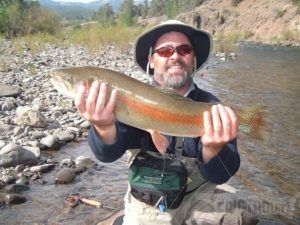
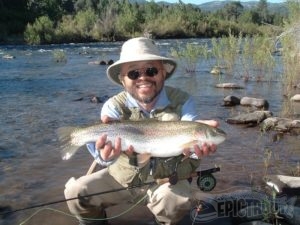
It’s not for everyone, and it’s not for every water either, but on eastern sierra rivers such as the Truckee, East Carson and East Walker, indicator nymphing can produce the same numbers of trout throughout the day as the best flurries of action possible when fishing dries to the elusive, magical hatch that so many anglers wait for. What’s more, when the hatch doesn’t quite come off the way you expected, or the fish just don’t seem to believe in your dry flies, the right nymph, right on the bottom, can turn a tough trip into a great one.I

